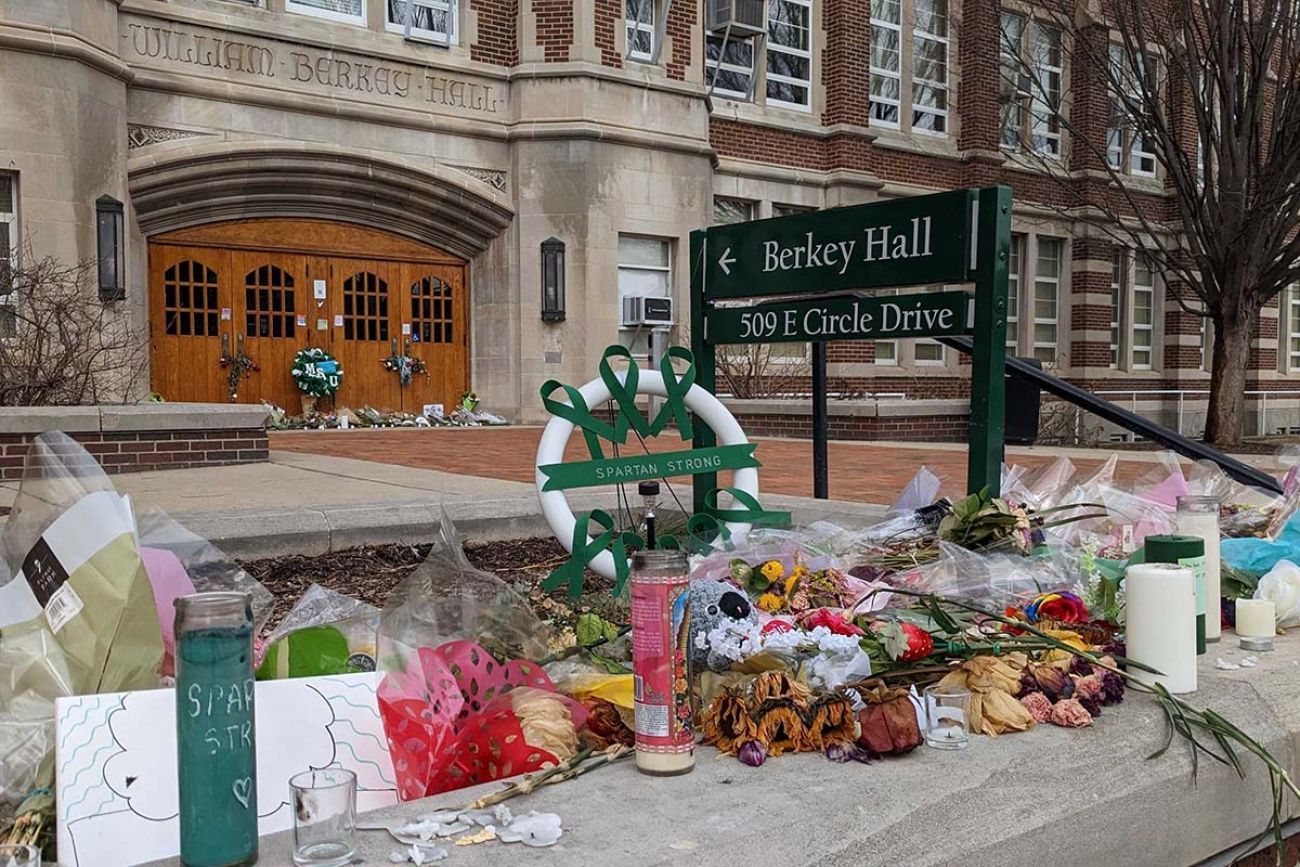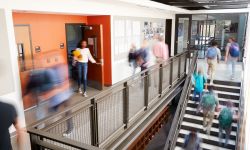As Michigan boosts school security after shootings, how much is too much?

- Gov. Gretchen Whitmer is allocating millions of dollars to put more police officers in schools and increase mental health efforts
- Research is mixed on the extent to which added security makes students safer from violent intruders
- Active shooter drills and other security measures can increase stress and depression among students and staff
In the wake of two deadly school shootings in Michigan in 15 months, a critical question persists: What’s the best way to keep students safe without jeopardizing why they’re in school in the first place?
“As much as people want to believe there's a single solution that can solve this problem, the simple reality is there’s not,” said Robert McCann, executive director of the K-12 Alliance of Michigan, a nonprofit education advocacy organization.
McCann told Bridge Michigan that more security is part of the answer to mass shootings at Oxford High School and Michigan State University. But he and others say it can undermine student learning if taken too far.
Related:
- Democrats push Michigan gun reforms. Here’s what the laws are now
- ‘We’re so angry.’ MSU students urge gun safety at Lansing hearing
- MSU police can’t explain 13-minute alert gap, remain mum on shooting details
“Is it a prison?” he asked. “There’s a real fine line there that can easily be crossed. And that leads us to where a child isn’t going to be ready to learn when they walk in the doors of a school.”
It’s a delicate balance for Michigan Gov. Gretchen Whitmer as she directs tens of millions of dollars toward hiring more K-12 school police officers, and millions more to address student mental health.
School and law enforcement officials say that added security, from armed officers to active shooter drills, is the price schools and colleges must pay to keep students safe. Pushing back, research on school security calls into question whether some of these efforts truly make schools safer — while affirming that they can deepen stress and depression among students.
Whitmer spokesperson Robert Leddy said the governor is committed to both school safety and student mental health.
“We agree that mental health supports need to be a critical piece of this overall investment, which is why the governor included an additional $29 million in this year’s budget on top of the $250 million investment from last year to get it done. The governor will continue to make needed investments in the classroom, school safety measures, and mental health supports,” Leddy said in an email.
Leddy noted that the 2022-2023 budget for K-12 provides districts $214 per student for campus safety and mental health support.
Doing something vs. doing too much
At Oxford High, students now walk through high-tech metal detectors at several entrances while an ammunition-sniffing dog patrols the school and grounds. They were added after a student entered the building in November 2021 with a handgun hidden in his backpack, which he used to kill four students and wound six students and a teacher.
At MSU, officials announced steps to boost campus security following last month’s shootings that killed three students and injured five. They include tightened access to buildings, adding door locks to secure 1,300 classrooms and installing more security cameras. MSU will also begin mandated active shooter drills for students and staff in the next academic year.
"The actions we are outlining today position us on a path to reclaim our sense of safety that was so violently taken away from our community,” MSU Interim President Teresa Woodruff said.
But reclaiming that sense of safety may prove difficult. A 2022 Stanford University report found that school shootings are linked to higher rates of depression and suicide in students exposed to the violence, and a drop in student enrollment and test scores at those schools.
It also found that students who survived a shooting were less likely to graduate from high school and college and more likely to be unemployed than students not exposed to a school shooting.
Given findings like that, it’s not hard to find administrative support for Whitmer’s plan to add $25 million to place armed police officers in K-12 schools, with priority given to smaller, more rural districts with few or no current officers.
Public Schools of Petoskey is getting $104,250 under the plan, welcome news to Superintendent Jeff Leslie. To be awarded a grant, districts must contribute a 50 percent match.
Leslie said the district will use the money to employ one full-time school resource officer who splits time between the district’s high school and middle school.
“As long as you’ve got the right person in that role, I think it definitely makes schools safer.”
But unlike schools where metal detectors are standard, Leslie sees little need for that in his largely rural district of about 2,700 students.
“The logistics of running your entire study body through metal detectors — imagine your whole school district going through airport security every morning. It’s just not feasible.”
But more than two decades after the 1999 shootings at Columbine High School in Colorado that killed 12 students and a teacher, there’s still no evidence-based consensus that beefed-up security measures in fact make students safer. There is evidence, however, that some security practices can increase student fears and adversely affect students of color.
In what appears to be the most comprehensive research into the impact of armed school officers on safety, a 2021 study by researchers at the University at Albany and RAND Corporation examined data from 12,000 public elementary, middle and high schools between 2014 to 2018 that added law enforcement officers.
The study found some benefits: The presence of armed officers appeared to reduce non-firearm offenses such as physical attacks and fights, as well as gun-related offenses.
But the study also found school resource officers add to “suspensions, expulsions, police referrals, and arrests of students” and that these outcomes were two times more likely for Black students than white students. And instead of reducing gun violence, the report found that adding school security officers “marginally increases the likelihood of a school shooting.”
Some metro Detroit students oppose the presence of armed police in schools. They’ve launched a petition drive opposing the governor’s directive to funnel $25 million over three years to add 195 school resource officers at dozens of districts across the state.
Janiala, who is African American, told Bridge the security measures at her Detroit high school — metal detectors, armed security guards, backpack searches — feel like a daily reminder that she’s somehow been criminalized. She asked that her last name not be used due to online attacks she received from previously speaking out publicly.
“You come to school and go through metal detectors. You have your backpacks open so they can check them,” Janiala said.
“As a person of color, any time a person in authority who carries around a gun to quote, unquote, keep me regulated and in check, it makes me feel unsafe and I know that’s not normal.”
A 2021 study reported in JAMA Network similarly found that “armed guards were not associated with significant reduction in rates of injuries” during school mass shootings.
On the other hand, the U.S. Department of Justice issued a 2020 report citing 12 cases where security resource officers appeared to play a role in thwarting potential school shootings. (Though in the Parkland shooting in Florida and at Oxford, school officers were accused of inaction during the deadly attacks.)
While studies are mixed, school officials face tremendous pressure from parents and their communities to show they are taking concrete steps to protect student safety.
South of Holland, Fennville Public Schools is a district of about 1,300 students nestled amid 112 square miles of fruit farms and tiny crossroads communities — about the last place some might expect a threat of school gun violence. It’s slated for nearly $160,000 in state funds to help pay for its first school resource officer.
“I believe we live in a pretty safe community,” Superintendent Jim Greydanus told Bridge.
“But from what I've heard from those who've had incidents, the first thing people say is, ‘We didn't think it could happen here.’ If an incident were to happen, that is where people point their fingers.
“People would look back and say, ‘Why didn't you do something to prevent this? You should have known.’”
Schools as security zones
School security levels vary widely at Michigan K-12 schools, from rural districts that have zero school resource officers or metal detectors to urban districts like the Detroit Public Schools Community District, which has its own police force and dozens of officers and contract security guards.
But while research shows students and staff report higher levels of stress in schools with visible security measures, law enforcement and security officials say studies can be misleading, and some trade offs are necessary to protect students during an attack.
Oxford was among many Michigan schools that drilled students in the active shooter drill known as ALICE: “Alert, Lockdown, Inform, Counter and Evacuate.” On the day of the shootings, students barricaded doors with desks and chairs, covered windows and some armed themselves with makeshift weapons from the classroom.
Oakland County Sheriff Mike Bouchard said ALICE training likely saved student lives that day.
“I think those drills were critical to reducing tragedy that day in terms of how many people were hurt,” he told Bridge.
Bouchard said research that appears to show school resource officers do not prevent school shootings may be flawed because it’s hard to measure an attack that never happened.
“It’s impossible to quantify what you prevent,” Bouchard said. “When you prevent something, you may or not know that you did. If you have a visible patrol in XYZ town in America and someone sees that who was planning to commit a crime and drives away, that will never be reflected in data.”
While most K-12 security measures are made at the district level, the state of Michigan requires all districts to conduct three school safety lockdown drills a year. It does not specify whether these are “active shooter” drills that stress strategies to stop a gunman when leaving the scene is not possible.
Here again, research does not make policy decisions easy for schools or elected officials. One study of shootings, which included the 2007 attack at Virginia Tech University that left 32 dead, showed “a clear pattern that those who took some form of defensive action at Virginia Tech fared much better than those who did not,” hinting at the benefits of training students for future attacks.
But schools must weigh those benefits against other research showing “shooter drills can negatively impact the well-being of school communities over prolonged periods of time,” causing “even seasoned teachers to break down at recess.”
In reality, the risk that any student, K-12 or college, will one day be threatened by an active shooter remains exceptionally low, leaving lawmakers and school officials to navigate the trade offs between preparation and students’ emotional health.
Some researchers say placing more emphasis on building a more inclusive, healthy school climate that doesn’t tolerate bullying means less need for visible shows of security, particularly when coupled with school threat assessment programs and strong mental health resources for students facing challenges.
Addressing student mental health is part of Michigan’ school security plan, too, as officials from the governor on down to local districts try to find the right balance.
“If we’re talking about hardening schools,” said McCann of the K-12 Alliance, “whether it's putting in more police officers or metal detectors, none of those things on their own is going to solve this problem if someone is determined to get a gun into school.”
See what new members are saying about why they donated to Bridge Michigan:
- “In order for this information to be accurate and unbiased it must be underwritten by its readers, not by special interests.” - Larry S.
- “Not many other media sources report on the topics Bridge does.” - Susan B.
- “Your journalism is outstanding and rare these days.” - Mark S.
If you want to ensure the future of nonpartisan, nonprofit Michigan journalism, please become a member today. You, too, will be asked why you donated and maybe we'll feature your quote next time!





